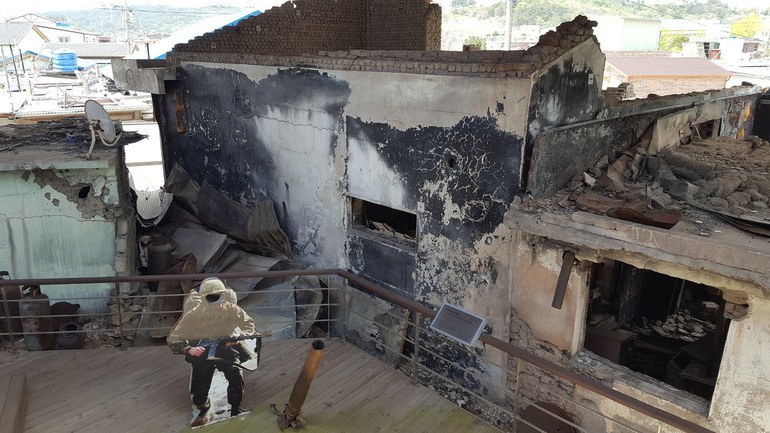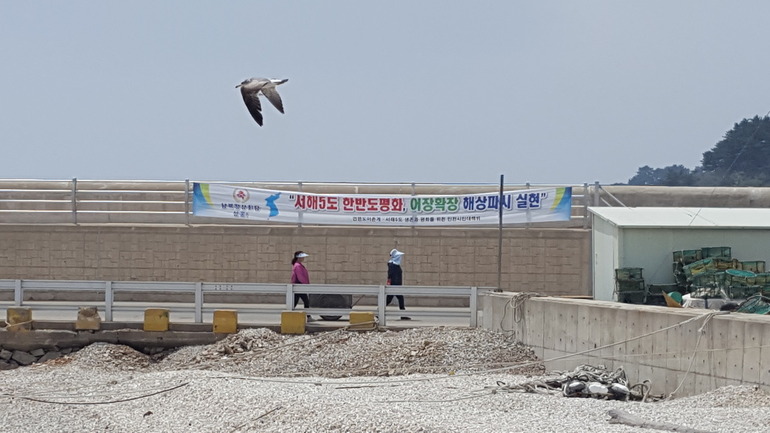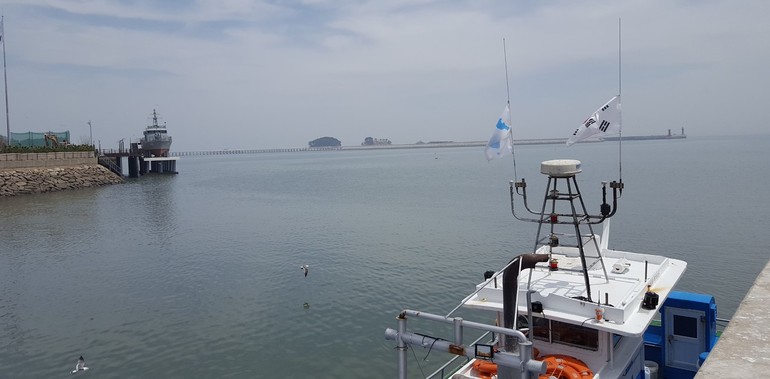Posted on : May.8,2018 16:51 KST
Modified on : May.8,2018 16:55 KST
 |
|
The preserved remains of a security education center on Yeonpyeong Island, Ongjin County, Incheon, that was destroyed by North Korean shells on Nov. 23, 2010. The site remains as is and is utilized for security education purposes.
|
Creation of maritime peace zone around West Sea Islands part of Panmunjeom Declaration
“I still shake when I think of that day.”
Seong Soon-gye brushed her hands over her chest as she remembered the events of Nov. 23, 2010. The 81-year-old was born and raised on Yeonpyeong, a small island in Ongjin County just over 100km from Incheon Port. The date in question was when the Yeonpyeong shelling occurred. Two marines and two civilians lost their lives, and 19 others were injured in the North Korean artillery attack that day.
“The windows at my house all shattered from the shock of the attack, and part of the roof was destroyed,” Seong recalled on May 7.
“I lived as a refugee on the mainland for about three months before returning and doing repairs, but I lost a lot of sleep for some time worrying about when the next shells might come,” she said.
 |
|
A banner along a pier hung by fisherman on Yeonpyeong Island in support of the formation of a joint maritime seafood market around the West Sea Islands, or what they refer to as the “Kaesong maritime complex”
|
A security education site is located around ten meters or so from Seong’s home. It remains preserved in its damaged state from the shelling reduced it to ruins: the roof caved in, the walls perforated and scorched by flames. With hostilities twice erupting in the nearby waters in 1999 and 2002, Yeonpyeong Island has been called the Korean Peninsula’s “powder keg.”
On the pier, Yeonpyeong fishermen have raised a banner expressing their hopes for a “Kaesong maritime complex” to be formed with the five West Sea Islands’ development into a maritime peace zone and the creation of a seasonal fish market.
But after seemingly endless hostilities between South and North, winds of peace are now blowing to Yeonpyeong Island and the other West Sea Islands. In the Panmunjeom Declaration issued after their Apr. 27 summit, the South Korean President Moon Jae-in and North Korean leader Kim Jong-un agreed to develop the area around the Northern Limit Line (NLL) in the West (Yellow) Sea into a maritime peace zone.
The declarations’ text states that the two sides “agreed to devise a practical scheme to turn the areas around the Northern Limit Line in the West Sea into a maritime peace zone in order to prevent accidental military clashes and guarantee safe fishing activities.”
The scars of intense conflict remain, but Yeonpyeong residents were full of hope that their island home could re-emerge as part of a “peace zone.” Banners by the Yeonpyeong pier that day sent messages of welcome for the inter-Korean summit; on each fishing boat, a Korean Peninsula flag showing the five West Sea Islands fluttered in the breeze.
“It’s been just two years since I came to Yeonpyeong Islands, but it feels like the residents’ hopes for the inter-Korean and North Korea-US summits have been higher than ever before,” said Ahn Gwang-gi, the 61-year-old principal of Yeonpyeong Elementary, Middle and High School. The combined school was formed after Yeonpyeong’s middle and high schools were damaged in the shelling and relocated to the elementary school.
Inter-Korean summit results in fresh tourism to Yeonpyeong Island
Vacant homes and restaurants that were closed down after the attack also showed signs of busy renovation. Recently opened restaurants could be seen. Signs of new life had begun to show for security tourism and the bed and breakfasts that had endured strained inter-Korean relations during the presidencies of Lee Myung-bak (2008–13) and Park Geun-hye (2013–16). A steady stream of visitors traveled to Yeonpyeong Island Hamsang Park, which shows a Chamsuri-class patrol craft similar in form to the vessels that fought in the Battles of Yeonpyeong.
“The number of tourists has been increasing since the inter-Korean summit,” said 72-year-old Kim Gwi-jin, who runs a bed and breakfast near the pier.
Fishermen stand to benefit the most from a maritime peace zone designation. They are counting the days until the five West Sea Islands take on a new life as a “golden fishery.”
“Fisherman on the five West Sea Islands have had to swallow the bitter reality of Korea’s division,” said Park Tae-won, who heads Yeonpyeong’s fishing village society.
“If a maritime peace zone is created and we can achieve joint fishing by inter-Korean fisherman and a maritime seasonal market for inter-Korean seafood trade, then even the invisible ‘maritime armistice line’ on the NLL in the West Sea will become a symbol of the Korean War’s end like Panmunjeom,” Park predicted.
On May 5, a joint visit to Yeonpyeong was paid by Minister of National Defense Song Young-moo, Minister of Foreign Affairs Kang Kyung-wha, Minister of Unification Cho Myung-gyon, and Minister of Oceans and Fisheries Kim Young-choon. The four arrived to hear resident opinions on the creation of a maritime peace zone, which is to be a key agenda item ahead of inter-Korean military talks sometime this month. The residents agreed that security was the primary concern, while joint fishing zone designation could come afterward.
“With the two Battles of Yeonpyeong and the shelling, Yeonpyeong residents haven’t been able to rest easy for a single day since the war,” said boat owners’ association director Seong Do-gyeong in a roundtable that day, before calling for “a ban on all attacks and making the waters of Yeonpyeong into ‘waters of peace.’”
 |
|
Since early April, fishing boats along Yeonpyeong Island have been flying Korean Peninsula flags that depict the five West Sea Islands. On the left is pictured a Chamsuri-class patrol craft similar to the vessels that fought in the Battles of Yeonpyeong. (Photos by Lee Jung-ha, Incheon correspondent)
|
The Incheon Citizen Countermeasures Committee for the Survival and Peace of the Five West Sea Islands, an organization of fishermen’s and civic groups from the islands, has sent a proposal to the South Korean government for the designation of joint inter-Korean fishing zones and fishing resource protection zones, permissions for nighttime fighting, and the establishing of a barge-operated maritime seasonal market.
Because of the military standoff between South and North, residents of the five West Sea Islands are currently only able to fish between the hours of 6 am and 6 pm. The committee also demanded the establishment of a civilian-government consultative group for the creation of a maritime peace zone, with fisherman from the islands and representatives of Incheon-area civic groups participating.
By Lee Jung-ha, Incheon correspondent
Please direct comments or questions to [english@hani.co.kr]











